Physical Address
304 North Cardinal St.
Dorchester Center, MA 02124
Physical Address
304 North Cardinal St.
Dorchester Center, MA 02124

Discover the 22 essential elements that define a traditional kitchen interior, from classic cabinetry and natural stone to architectural details that create timeless, welcoming spaces built to last for generations.
We talk a lot about kitchen trends. They come and go with the seasons—new colors, new gadgets, new layouts promising to change our lives. But I find the conversations I have with clients, and frankly, the ones I have with myself, always circle back to something more permanent. We’re not really looking for what’s new; we’re looking for what will last.
This is where the idea of a “traditional” kitchen comes in, and I know that word can be loaded. It might bring to mind fussy, dark spaces from a bygone era. But I want you to set that image aside. From my perspective—one rooted in the clean lines and natural honesty of Scandinavian design—a traditional kitchen is not about a specific style. It’s about a philosophy. A commitment to craftsmanship, natural materials, and creating a space that feels as good as it looks. It’s about building the true heart of your home.
So, let’s walk through the elements that give a kitchen this lasting quality. Think of this less as a checklist and more as a guide to the ingredients of a space that you will love for years, not just a season.
The cabinetry is the architecture of your kitchen. It sets the entire tone. Two styles have proven their worth time and again: Shaker and Raised Panel. The Shaker cabinet is a masterpiece of functional design—a simple, five-piece door with a recessed center. There’s an honesty to it that I deeply appreciate; it was born from a community that believed in utility and simplicity, principles that resonate strongly in Nordic design. It doesn’t shout for attention. It’s confident in its quiet competence.

Raised Panel cabinets offer a bit more detail, with a center panel that is elevated and often has beveled edges. This style has roots in classical millwork and speaks to a more formal tradition of craftsmanship. Choosing between them isn’t about right or wrong; it’s about the story you want to tell. Are you aiming for understated elegance or a more formal, architectural presence? Both provide a solid, timeless foundation that can support a range of interpretations, from a rustic farmhouse feel to something more refined.
This choice in cabinetry really becomes the canvas for everything else. And the most natural color for that canvas is often the material itself.
There’s a reason we instinctively feel at ease in a room with wood. It’s a connection to the natural world that synthetic materials can never quite replicate. In a lasting kitchen design, warm wood tones are essential for creating an inviting atmosphere. Cherry, with its rich, reddish hue that deepens to a beautiful patina over the years, is a classic. Oak brings a strength and a prominent grain that feels grounded and reassuring. Maple offers a calmer, smoother look, while alder is wonderfully versatile, taking stains with a soft, even character.
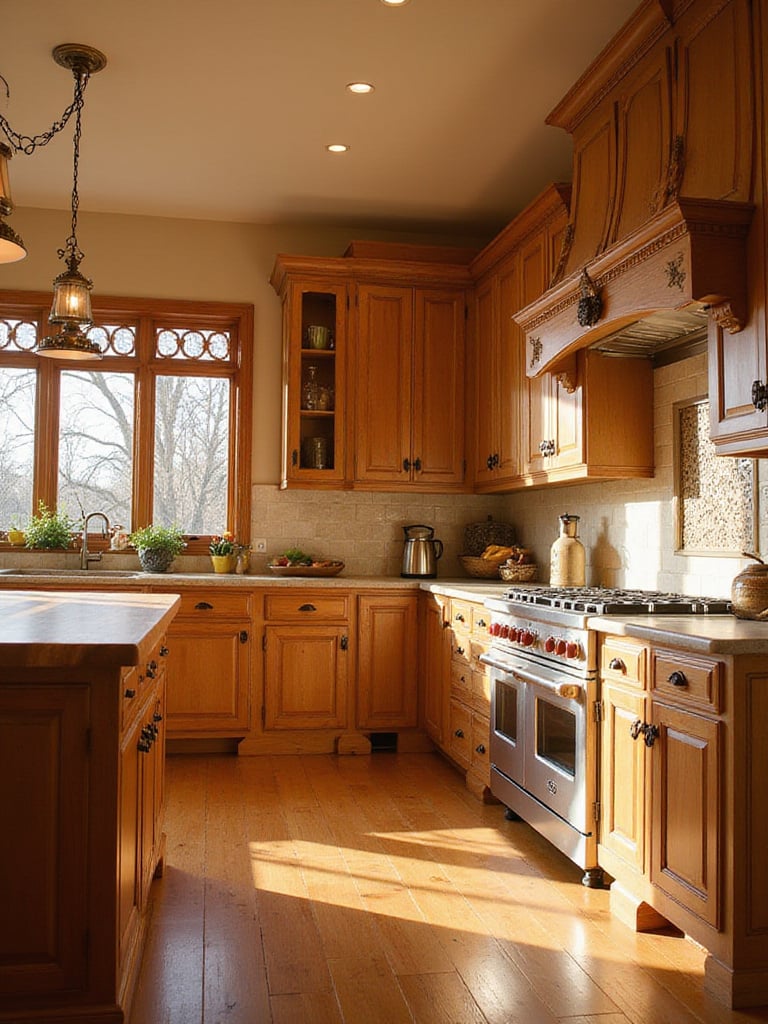
I remember a project in a home with lots of cool, northern light. We chose alder for the cabinets with a light, honey-toned stain. The moment they were installed, the entire room felt warmer, more human. The key is to let the wood be itself. Finishes should enhance the grain, not hide it. Whether it’s the flooring underfoot, the beams overhead, or the cabinetry you touch every day, these layers of wood create a depth and texture that feels like home.
These natural tones in the wood almost demand a counterpart that’s just as authentic, which leads us directly to the work surfaces.
Marble and granite. These materials aren’t just old; they’re ancient. Each slab has a story that spans millennia, a unique piece of geological art that you get to live with. This authenticity is why they feel so right in a kitchen built to last. The sweeping veins in a cut of marble or the complex patterns in granite provide a visual richness that complements detailed cabinetry perfectly.

Now, here’s where it gets tricky, and where you have to be honest with yourself. Marble is, without question, breathtakingly beautiful. It’s also softer, more prone to etching and staining. Granite is the workhorse—incredibly durable and forgiving. I’ve seen clients agonize over this choice. My advice? Be realistic about your life. If the thought of a red wine ring sends you into a panic, the quiet strength of granite or even a high-quality quartzite might be your answer. But if you can embrace the Japanese concept of wabi-sabi—finding beauty in imperfection—then a marble countertop that shows the faint marks of family dinners and celebrations becomes a storybook of your life at home.
Once you’ve chosen these large, foundational pieces, the next step is adding the details that you interact with most intimately.
It’s often called the jewelry of the cabinets, and for good reason. Hardware has an impact that far outweighs its size. A well-chosen knob or pull is a tactile point of connection, something you touch dozens of times a day. You can feel quality here. It has a satisfying weight, a solid feel in your hand that cheap, hollow pieces just don’t.
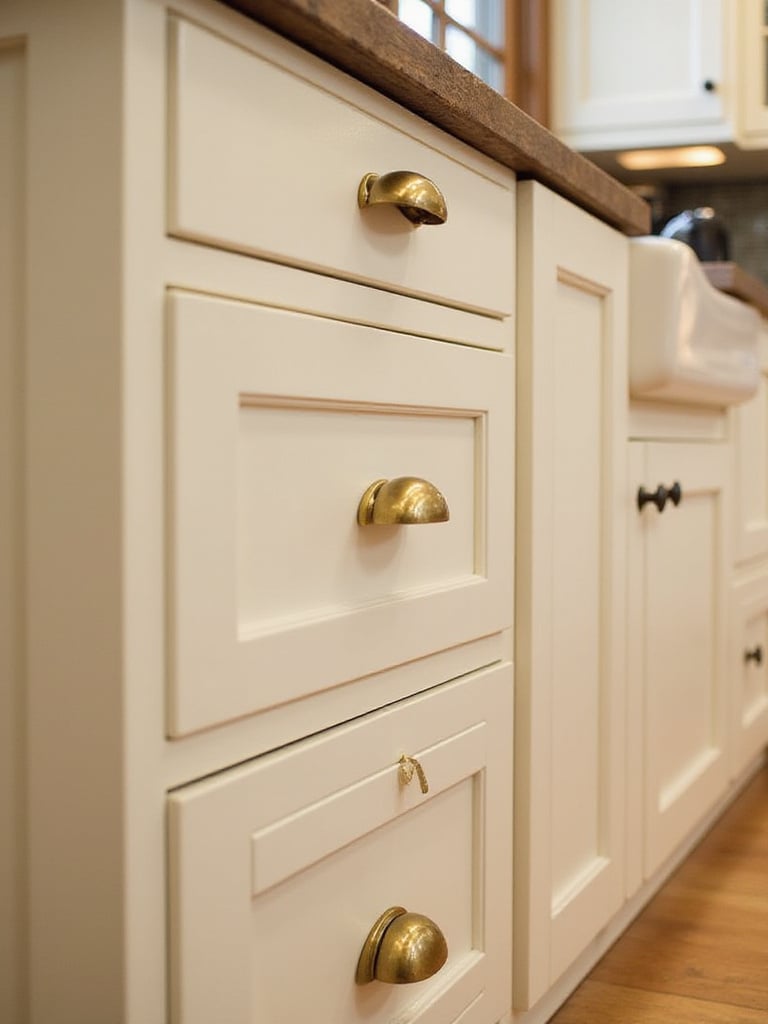
Mushroom knobs, bin pulls, and simple bail pulls are classics for a reason. They work. For materials, look to metals that age gracefully. Brass, bronze, and nickel are mainstays. I’m personally drawn to unlacquered brass, which starts bright and polished but develops a deep, rich patina over time. Each one becomes unique. Polished nickel offers a clean, classic shine, while oil-rubbed bronze provides an immediate sense of age and warmth. Don’t be afraid to mix it up. Sometimes using knobs on doors and pulls on drawers can add a subtle layer of interest.
This focus on the small, tactile details extends right down to the floor you walk on.
The floor in a kitchen has to work hard. It needs to be resilient, beautiful, and feel good to stand on. Solid hardwood is a natural choice, bringing warmth and a certain softness that’s more forgiving on your feet and on dropped dishes. Oak, maple, and cherry are excellent options that develop a beautiful character with age. Yes, you have to be mindful of water, but modern finishes have made wood far more durable in a kitchen environment than it used to be.
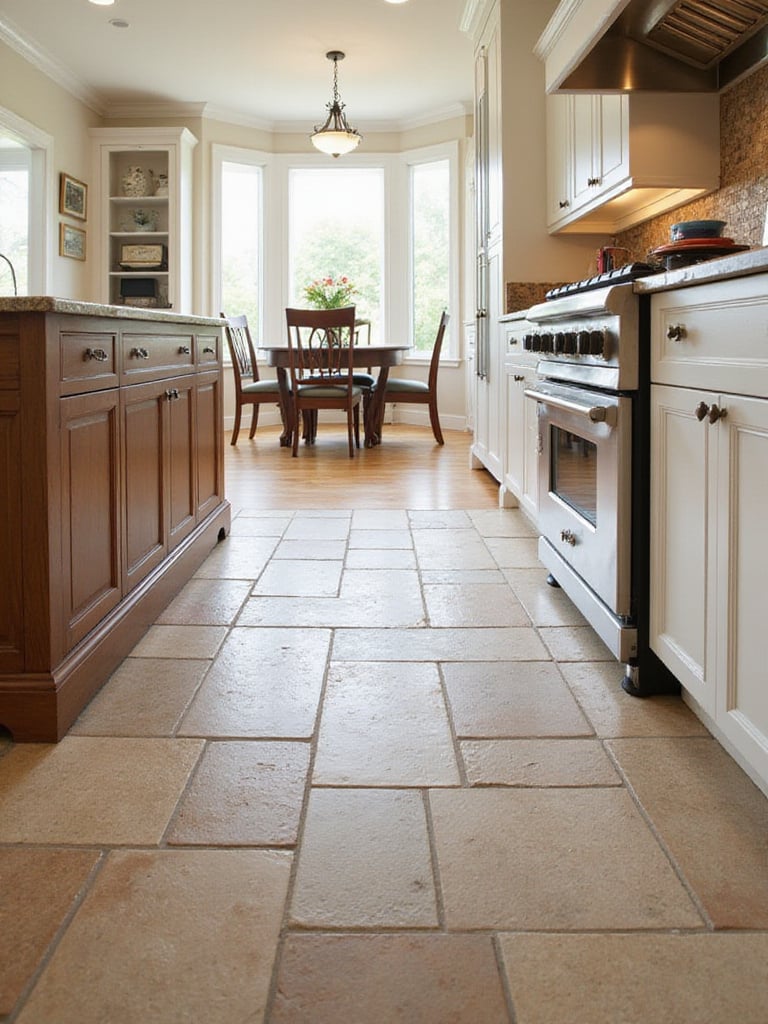
Classic tile is the other hero. Whether it’s natural stone like travertine and slate or a classic ceramic pattern, tile offers incredible durability and endless design possibilities. It can feel cold, I’ll admit, but that’s easily solved with underfloor radiant heating—one of the best small luxuries you can give yourself. The choice comes down to feeling. Do you want the organic warmth of wood or the steadfast permanence of stone? Both have deep historical roots and provide an authentic base for the room.
From the floor, our eyes are naturally drawn to another functional anchor of the space: the sink.
The apron-front, or farmhouse, sink is more than just a trend. Its design is rooted in pure function. Centuries ago, before modern plumbing, these deep, generous basins were essential for holding large amounts of water and washing everything from laundry to vegetables. That practicality is what makes them so appealing today. The large basin easily accommodates oversized pots and pans, and the exposed front means you’re not leaning uncomfortably over a strip of countertop to do the dishes.
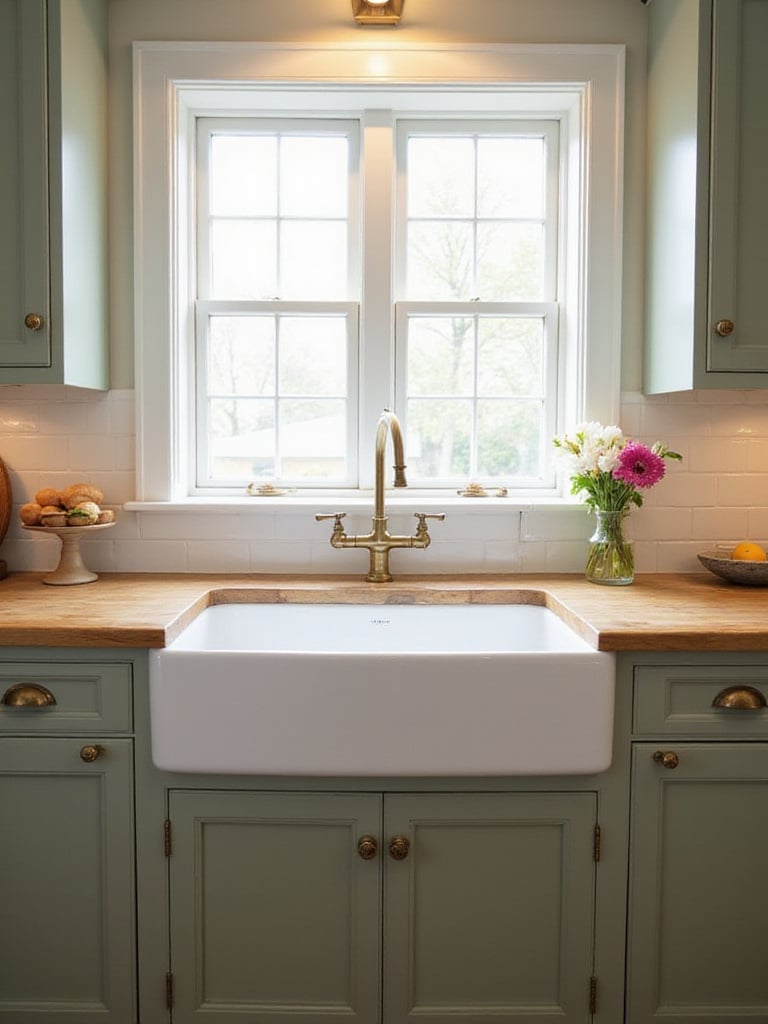
Fireclay is the most iconic material—incredibly durable with a smooth, hard surface that resists just about everything. But you can also find them in cast iron, copper, or even soapstone. What I love is how this single element can add so much character. It has a gravitational pull, a substance and presence that a standard undermount sink just can’t match. It feels both humble and heroic, a perfect embodiment of the traditional kitchen ethos.
And what good is a beautiful sink without an equally well-designed faucet to complete the picture?
The faucet is a working sculpture. In a traditional kitchen, you’ll often see two primary forms: the bridge faucet and the gooseneck. The bridge faucet, with its separate hot and cold lines connecting to a central “bridge,” is a nod to a time before single-handle mixing valves. It has a certain mechanical elegance, an honesty about how it works that I find very appealing.

Gooseneck faucets are defined by their high, graceful arc. This isn’t just for looks; that high curve is incredibly practical for filling tall pots or a bucket. In a traditional setting, these faucets often feature classic cross handles or levers and are made from substantial, solid metals. The craftsmanship reveals itself in the details: the smooth action of the valve, the solid feel of the handles, the quality of the finish. This is an element you interact with constantly, so investing in a well-made piece is a decision you will never regret.
This pairing of a strong sink and an elegant faucet needs a backdrop that ties it all together.
The backsplash protects the wall, but its design role is much larger. It’s the visual bridge between your countertops and your upper cabinets. Here, simplicity often wins. The classic 3×6 inch subway tile is almost never a bad choice. It originated in the New York City subway for a reason: it’s durable, easy to clean, and its simple grid provides a sense of order without being distracting. It can be a quiet background player or, with a contrasting grout, become a more graphic element.

For a different kind of character, natural stone slabs or tiles—like marble, travertine, or slate—bring organic movement and texture. Using the same material as your countertop for the backsplash creates a seamless, monolithic look that is both dramatic and deeply calming. Both subway tile and natural stone possess a timelessness that comes from their material integrity. They aren’t tied to a fleeting trend, which is why they remain such powerful choices for a kitchen built to endure.
And just above that backsplash, over the range, is an opportunity to create a true focal point.
The range hood has evolved from a simple appliance into a major architectural feature. In a traditional kitchen, it often becomes the visual anchor for the primary cooking wall, much like a fireplace mantel is the anchor of a living room. Mantel-style hoods, with their supportive corbels and detailed trim, explicitly evoke this sense of a hearth—the historical center of the home.
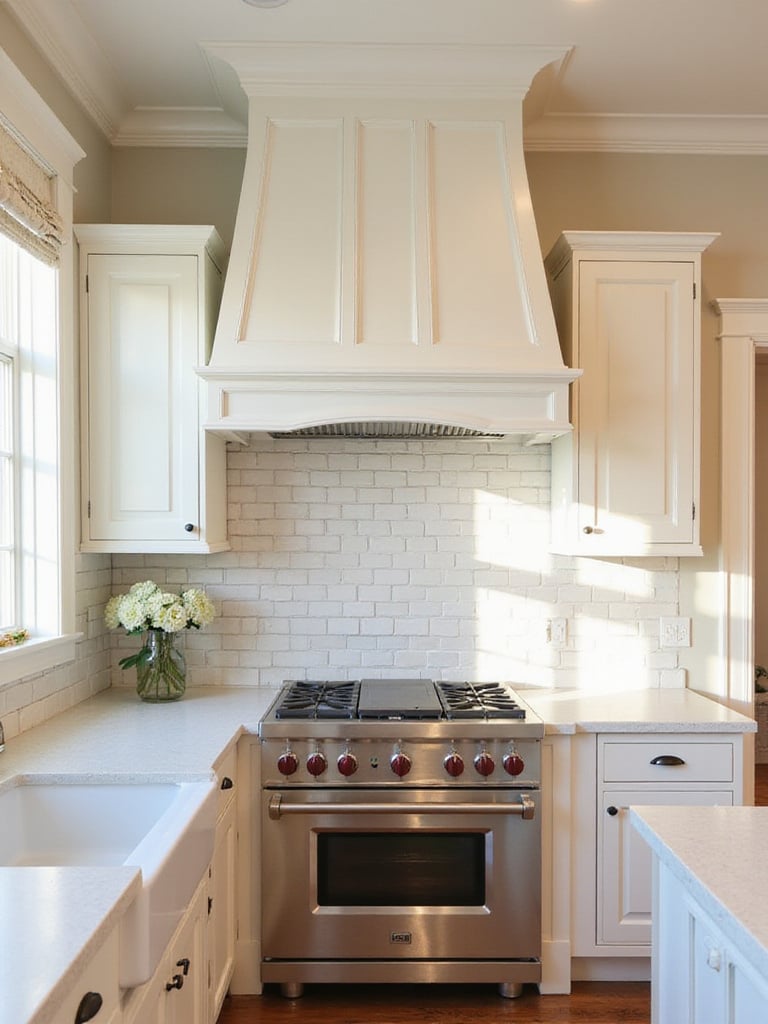
Another approach is to create a paneled hood that integrates seamlessly with the surrounding cabinetry. By facing the hood with panels that match the cabinet doors, you create a cohesive, custom, built-in look that feels intentional and solid. This move conceals the mechanics behind a beautiful facade, a principle that values a serene appearance over a display of technology. Crafted from wood and finished to match the rest of the kitchen, the range hood becomes a powerful statement of permanence and craftsmanship.
This idea of built-in character extends to the fine details that truly finish a room.
What separates a nice kitchen from a truly beautiful one? Often, it’s the architectural details. Crown molding is the most common example. It provides a graceful transition from the top of your cabinets to the ceiling, giving the room a polished, complete look. It sounds like a small thing, but a kitchen without it can feel abrupt, unfinished.elevate the space beyond simple cabinetry and countertops.
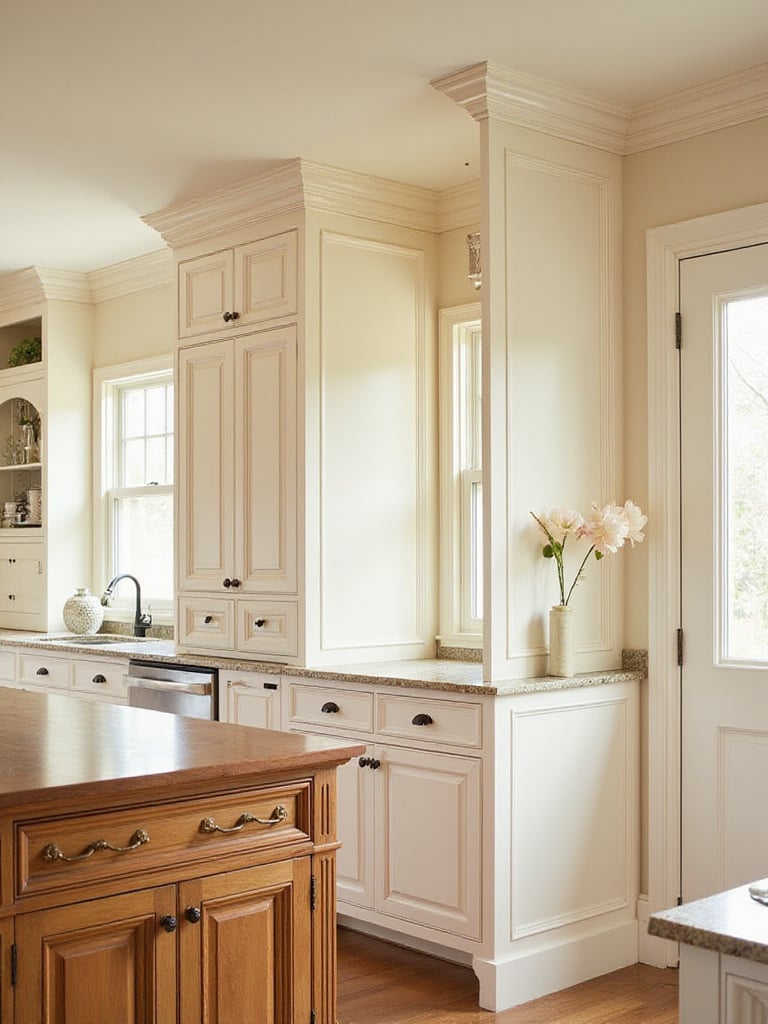
But it goes beyond just crown molding. Think about substantial trim around windows and doors, decorative corbels supporting an overhang, or the simple, textural appeal of beadboard or wainscoting on a wall or island back. These elements add layers of depth and shadow that make a space feel rich and established. They mimic the details found in older, well-built homes, reinforcing that feeling of timeless quality. It’s a design language that speaks of permanence.
This language of permanence also applies to how we handle our modern necessities.
Let’s be honest: a giant stainless steel refrigerator can be the loudest thing in the room. In a kitchen that values the warmth of wood and stone, the prominent gleam of modern appliances can feel disruptive. The solution is integration. This is achieved with “panel-ready” appliances, designed to accept a custom panel that matches your cabinetry perfectly. Suddenly, your dishwasher and refrigerator disappear, blending into the background.
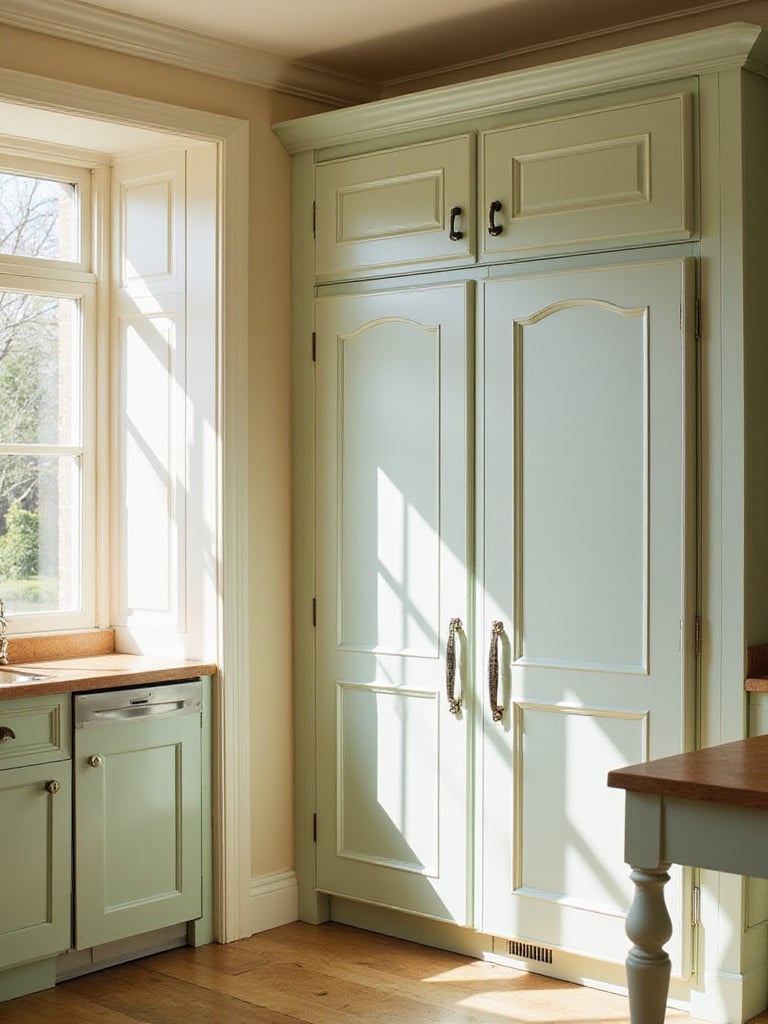
This isn’t about hiding from technology. It’s about letting the craftsmanship of the kitchen take center stage. The goal is to make the space feel more like a beautifully furnished room and less like a laboratory. It’s a concept that dates back to the early “fitted kitchens” in Europe, where designers sought to create a more harmonious whole. One unexpected benefit I’ve noticed on projects: custom panels don’t show fingerprints and smudges like stainless steel does. A small but significant victory in daily life.
This idea of making functional elements feel more like furniture is perfectly expressed in the kitchen island.
A kitchen island is a workhorse, but it doesn’t have to look like a big, monolithic block. One of the most effective ways to give an island a sense of grace and character is to treat it like a piece of furniture. This is often done by incorporating furniture-style legs—turned, carved, or tapered supports that replace a solid corner.
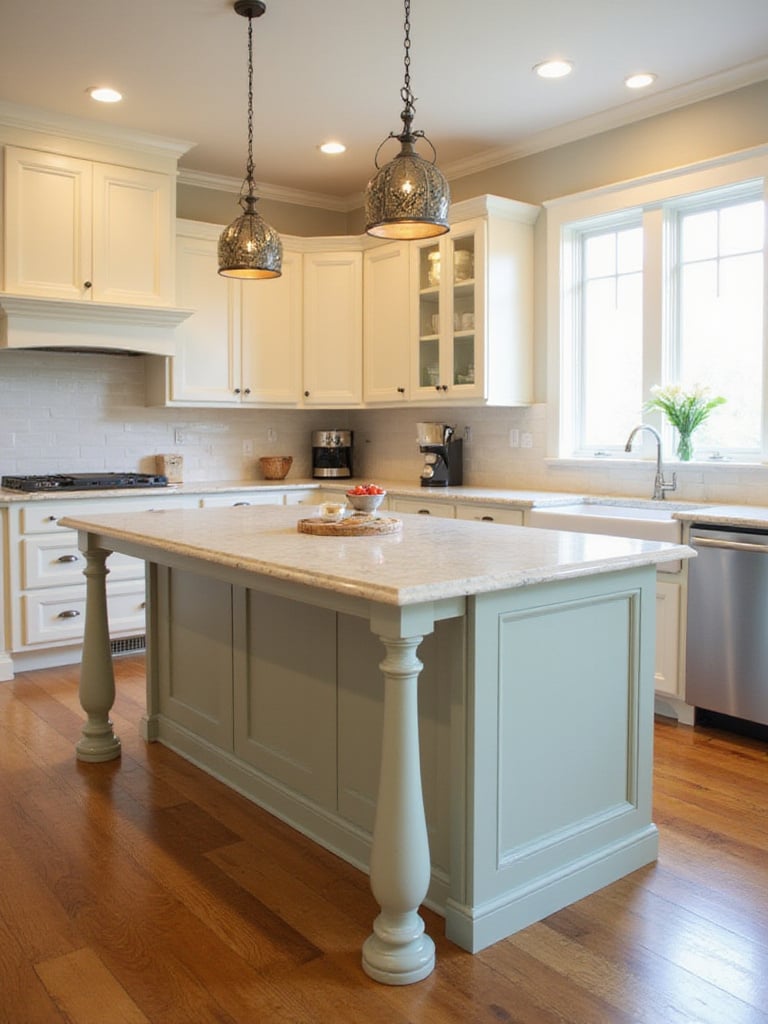
This simple change visually lifts the island off the floor, making it feel lighter and more like a freestanding table or console. It introduces an element of elegance that contrasts beautifully with the island’s functional purpose. You can match the leg style to a specific historical period—from simple Shaker tapers to more ornate Victorian turnings—to reinforce your kitchen’s specific traditional voice. What I love is the pairing of these more delicate-looking legs with a substantial, thick countertop. That contrast between refined detail and robust function is where real design magic happens.
And floating above that island, you have a perfect opportunity to add another layer of personality.
Lighting does more than just help you see what you’re chopping. It creates the entire mood of the space. In a traditional kitchen, decorative fixtures like pendants over an island or a chandelier over a dining nook are critical. This isn’t just task lighting; this is ambient lighting, the general glow that makes the room feel warm and welcoming for gathering.
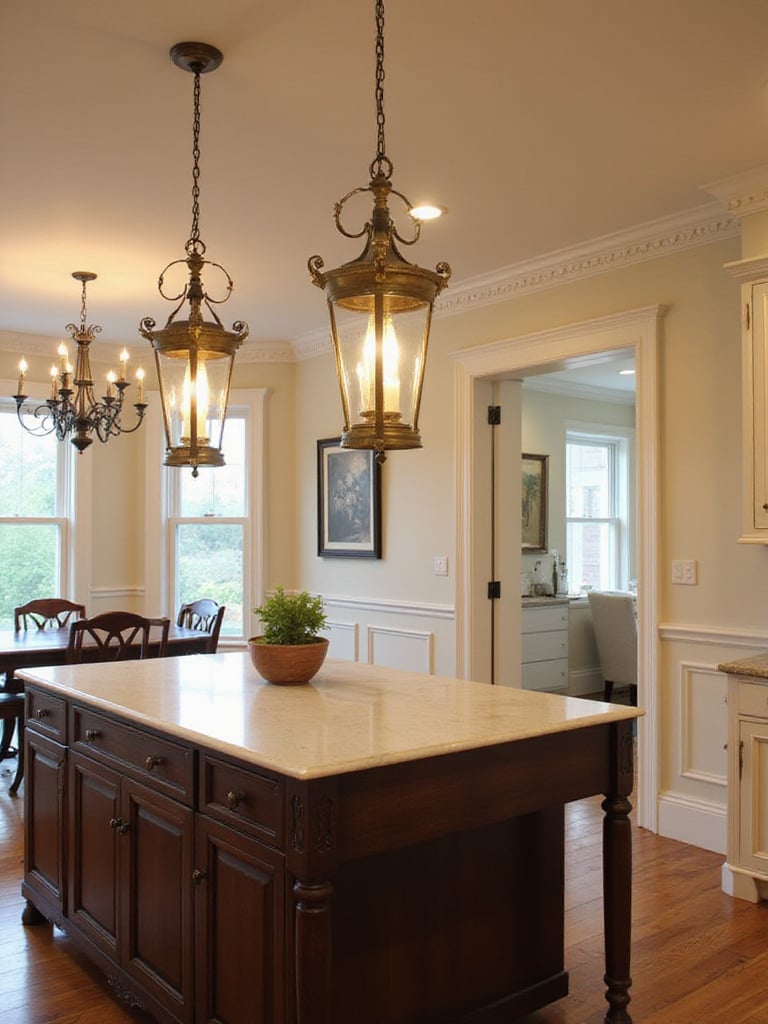
Look for fixtures that have a sense of history. Classic lantern-style pendants, schoolhouse fixtures with milky glass, or simple bell-shaped shades in aged brass or oil-rubbed bronze all work beautifully. A chandelier can add a touch of unexpected formality and sparkle. These fixtures are focal points. They draw the eye upward and add character, breaking up the straight lines of cabinetry and a flat ceiling plane. When you dim them in the evening, they transform the kitchen from a workspace into a cozy room for relaxing and connecting. That, to me, is the essence of hygge.
This desire for light and warmth also informs how we think about our storage.
A long wall of solid cabinet doors can feel heavy. Breaking it up with sections of glass-front cabinets is a classic strategy to make the kitchen feel lighter, more open, and more personal. They serve a dual purpose: providing protected storage while allowing you to display cherished dishware, glassware, or serving pieces.

You don’t have to put your entire life on display. The glass itself can add character. Clear glass is perfect for showing off a prized collection. But I often suggest seeded or reeded glass. Seeded glass, with its tiny bubbles, and reeded glass, with its vertical lines, both subtly obscure the contents while beautifully catching and diffusing light. Strategically placing these cabinets—perhaps flanking the sink or range—creates a focal point and adds a layer of depth that makes the kitchen feel custom and thoughtfully designed.
For a more casual and accessible approach to display, a bit of open shelving can work wonders.
I know open shelving can be intimidating. The fear is clutter. And it’s a valid one. But used sparingly and thoughtfully, a few open shelves can add immense character and a lived-in charm. In a traditional context, this isn’t about tearing out all your upper cabinets. It’s about creating a small, curated moment.
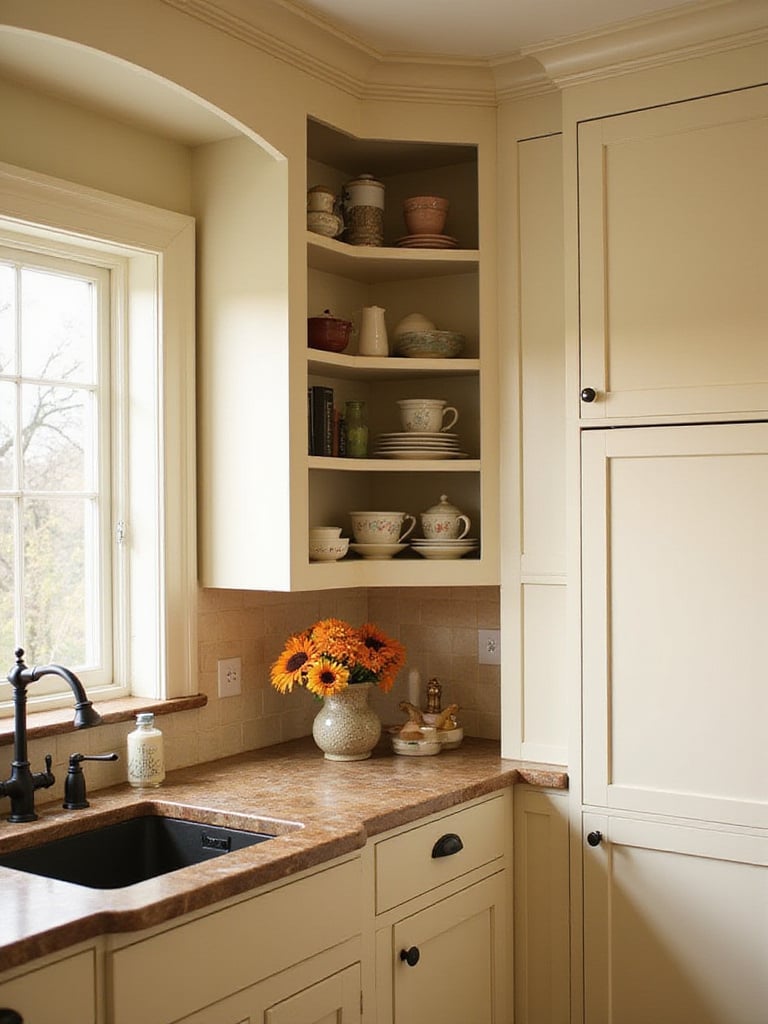
What should you display? Think of items that are both useful and beautiful. A neat stack of your everyday ceramic plates, a collection of glassware, your most-used cookbooks, or a few small potted herbs. This is a place for the things you reach for constantly or items that tell a story. The key is curation. It’s an intentional edit. I often use a single, thick wood shelf between two windows or at the end of a cabinet run to add a touch of warmth and personality without sacrificing the organized feel of the kitchen.
All these elements—the wood, the stone, the displayed items—are brought to life by the color palette that surrounds them.
Color sets the emotional temperature of a room. For a space that feels timeless and comforting, nothing works better than a palette of warm whites, creams, and gentle earth tones. These colors are rooted in the natural materials that have been used in homes for centuries—the color of chalky limewash paints, aged wood, stone, and clay.
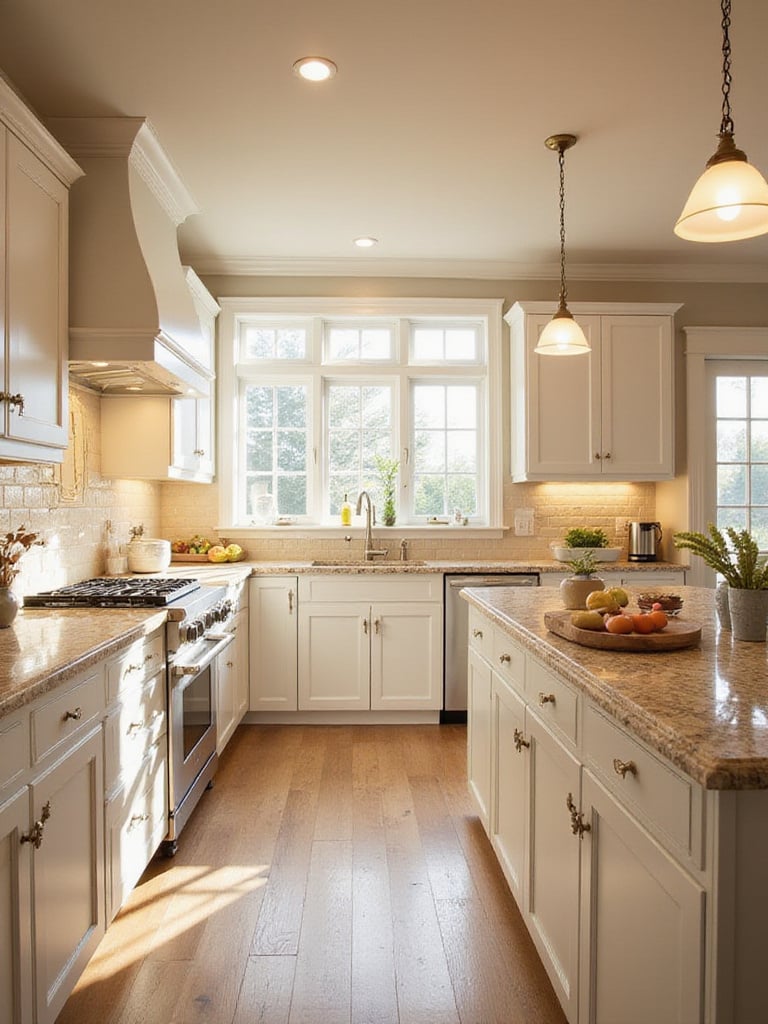
A “warm white” is a white with a subtle undertone of yellow, pink, or beige. It feels softer and more inviting than a stark, clinical white, which can have blue undertones. These warm whites prevent a space from feeling cold and create a cozy, enveloping atmosphere. They are the perfect backdrop. For accents, look to the earth: sandy beiges, muted sage greens, dusty blues, or even a soft terracotta. These colors are inherently calming because they feel grounded and familiar.
This grounded feeling is also reflected in the very layout of the room.
A beautiful kitchen that doesn’t work well is a failure. Functionality is paramount, and traditional layouts are often beautifully logical. Many adhere to the classic “kitchen work triangle,” the ergonomic principle that places the sink, refrigerator, and range in an efficient relationship to minimize steps during cooking.
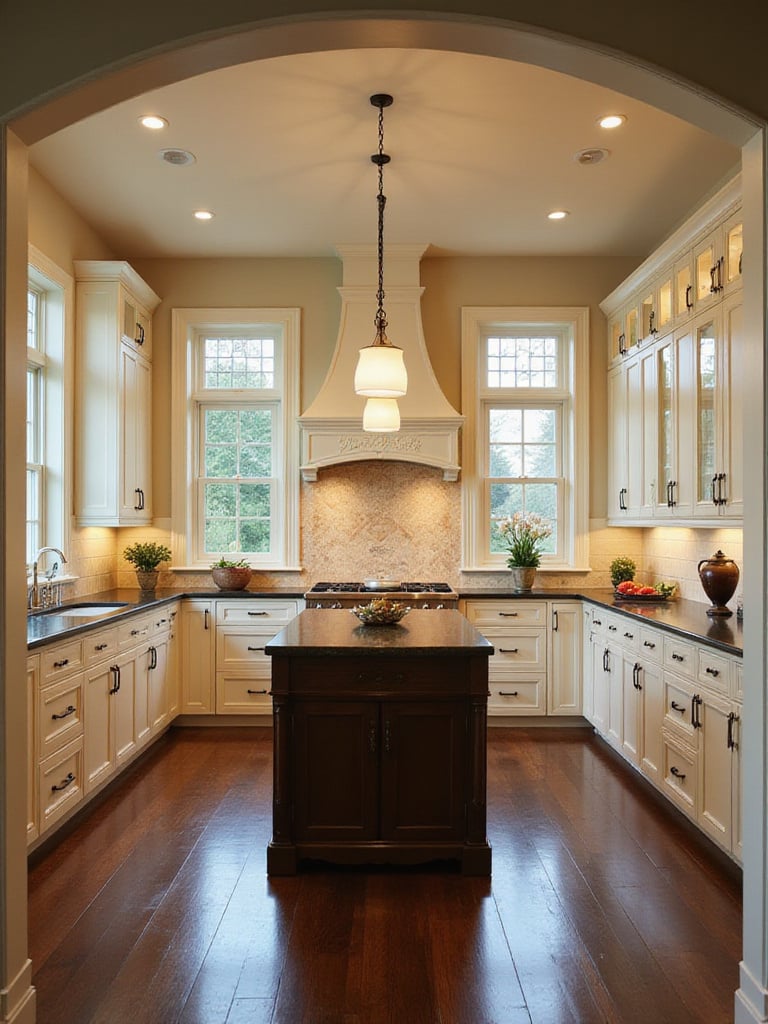
Beyond pure function, traditional design often employs symmetry to create a sense of calm and order. This might mean centering the range on a wall and flanking it with identical cabinets, or placing a window perfectly in line with an island. Does everything have to be perfectly symmetrical? Absolutely not. Life isn’t symmetrical. But using symmetry as a guiding principle for the main architectural elements creates a powerful sense of balance and harmony. It’s a visual quietness that allows the details and materials to shine.
Within this balanced layout, there’s always room to carve out a space specifically designed for comfort.
There’s something irresistibly cozy about a built-in banquette or window seat. It’s an architectural hug. These nooks, often tucked into a corner or under a window, create a dedicated spot for casual meals, morning coffee, or homework supervision. They are inherently intimate and space-efficient.

Historically, built-in seating was a common-sense solution to maximize space and foster closeness. Today, it does the same. An L-shaped or U-shaped banquette can seat more people more comfortably than a set of chairs in the same footprint. And the space underneath the seat is a golden opportunity for hidden storage—perfect for stashing away seasonal items or extra linens. Introducing soft, upholstered seating into the hard surfaces of a kitchen completely changes the energy of the room, inviting people to linger.
This interplay between hard and soft materials is key to creating a truly engaging space.
A kitchen designed in a single, uniform texture can feel flat and lifeless, no matter how beautiful the color. The real magic of traditional design lies in its mastery of texture. It’s a natural result of using a variety of authentic materials. Think of the contrast between the smooth, painted finish of a cabinet, the honed (matte) surface of a stone countertop, the glossy sheen of a tile backsplash, the cool gleam of metal hardware, and the soft weave of a linen cushion on a banquette.
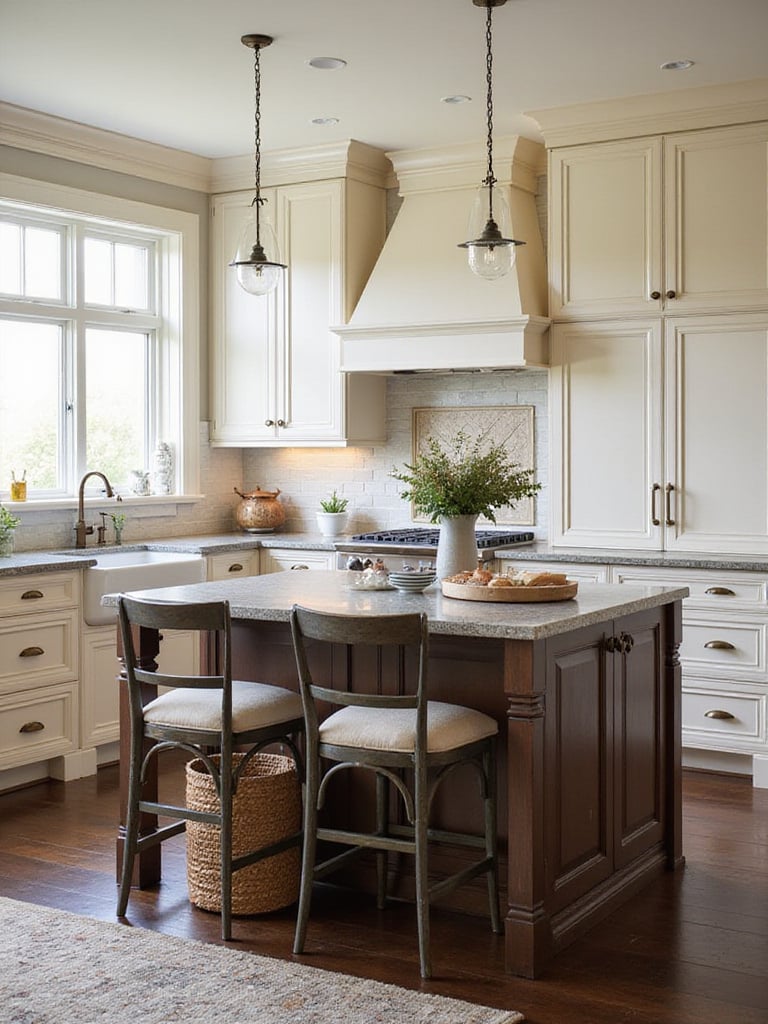
Each of these surfaces interacts with light differently. Glossy finishes reflect it, creating bright spots. Matte surfaces absorb it, creating a softer, deeper feel. Rough textures create tiny shadows that add complexity and depth. You don’t need a lot of different colors to make a room interesting. A kitchen designed in shades of cream and white can feel incredibly rich and layered if you incorporate a healthy mix of textures. It’s a subtle but powerful way to add dimension.
All these layers of texture, color, and detail point to one overarching principle.
More than any single element, a truly traditional kitchen is defined by an undeniable sense of quality. It feels like it was built to last, because it was. This is communicated through the choice of solid, durable materials—real hardwood, natural stone, thick butcher block—materials that don’t just endure but often grow more beautiful with age as they develop a rich patina.
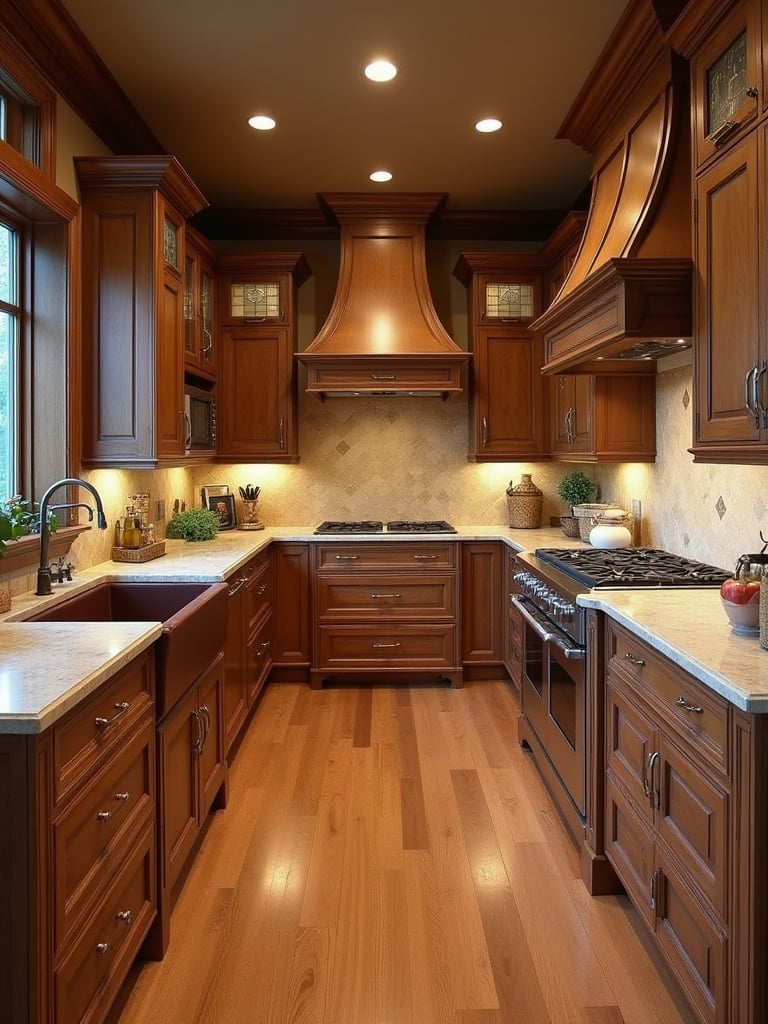
You can see the craftsmanship in the details. In the precision of the joinery, the substantial weight of the cabinet doors, the hand-carved details on a corbel, or the custom fit of an integrated appliance. This isn’t about just assembling boxes; it’s about artisanship. This commitment to quality is, in its own way, a commitment to sustainability. A well-built kitchen that remains beautiful and functional for generations is the opposite of today’s disposable culture. It’s an investment in your home and your family’s future.
And when all these pieces come together, they create something more than a room.
You can follow all the design rules in the world, but if the kitchen doesn’t feel welcoming, something has been lost. The ultimate goal of all these elements is to create a family-focused atmosphere. The large central island becomes a natural gathering point. Ample, comfortable seating encourages people to stay. Warm materials and soft, layered lighting create an ambiance that makes people instinctively relax.
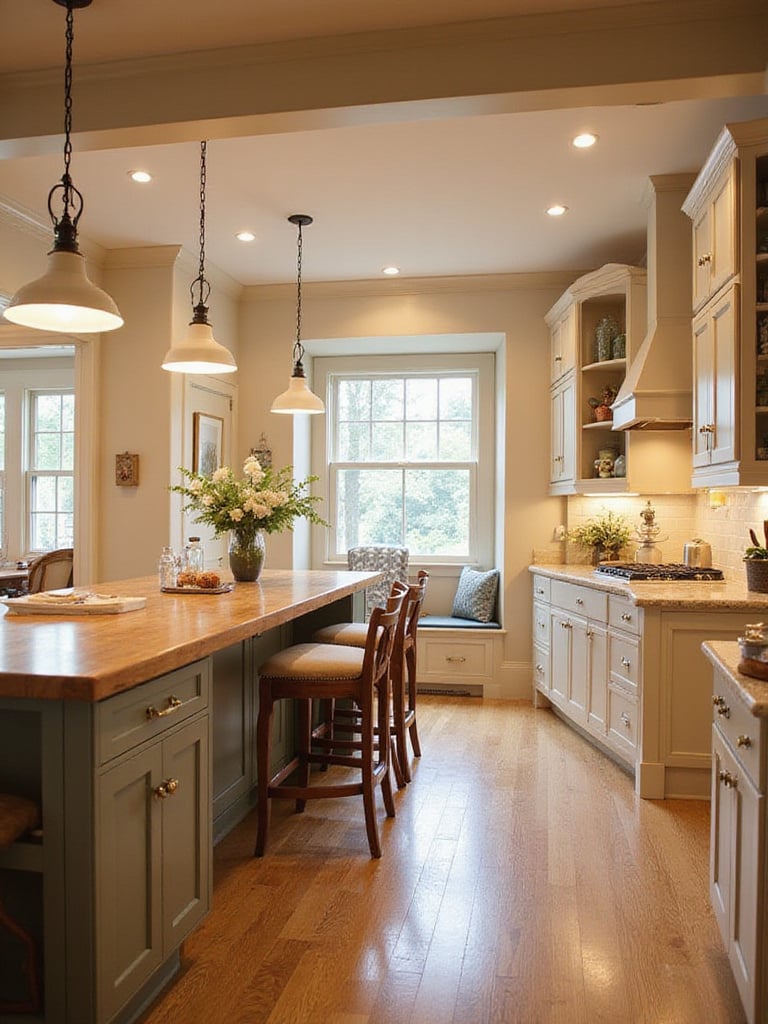
This is where the space comes alive. It’s where you display a few meaningful family heirlooms on an open shelf, where the marks on the marble countertop remind you of a party, where the big sink holds flowers from the garden. The design should support and encourage these moments. It’s about consciously crafting a backdrop for shared experiences and memory-making. It’s the feeling you get when you walk into the room and your shoulders just drop a little.
That feeling is powerfully enhanced by one final, crucial, and completely free element.
Natural light is a design material. It is as important as the wood or stone you choose. It brightens the space, revealing the true colors and textures of all the other materials. A kitchen rich with dark wood and stone can feel heavy without enough natural light to balance it.
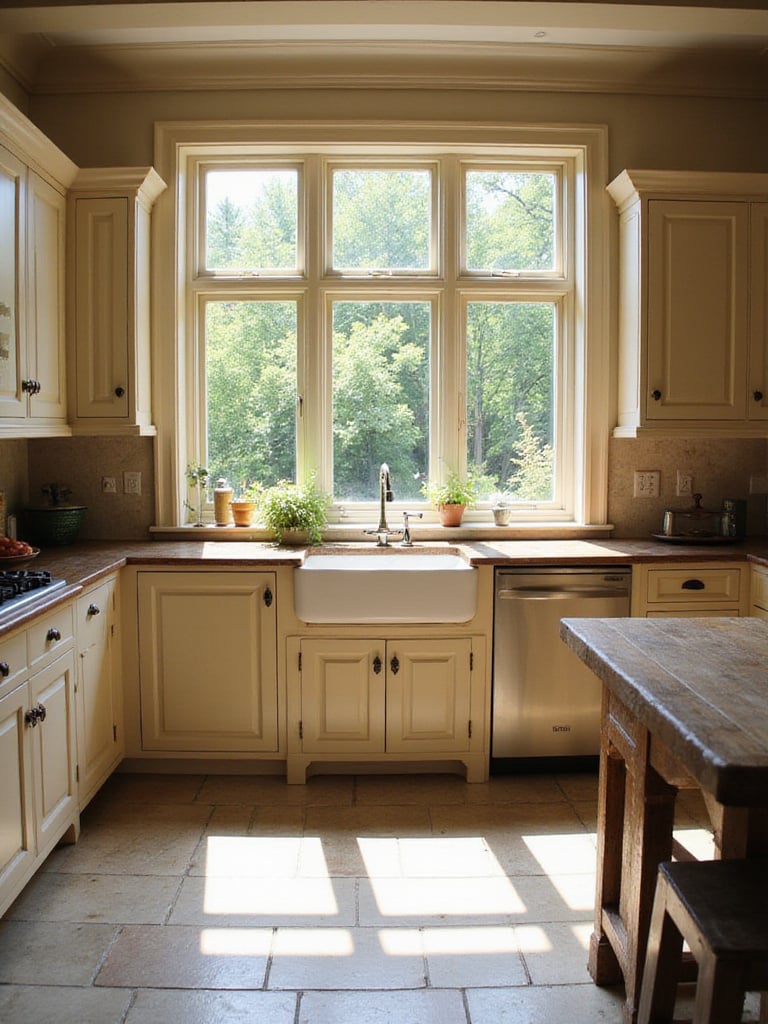
Traditional home design has always understood this, often incorporating large, multi-paned windows, bay windows over the sink, or even skylights to pull light into the core of the home. Abundant daylight makes any space feel larger, more airy, and more alive. It connects the interior to the outdoors, to the changing seasons and the time of day. As the morning sun streams in, it will cast long shadows and highlight the texture of a stone countertop in a way that no artificial light ever could. Designing to maximize that daily light show is one of the most impactful things you can do.
In the end, creating a kitchen with this kind of enduring appeal is about more than just combining a list of features. It’s a way of thinking. Choose permanence over trends, and craftsmanship over convenience. It’s about building a space that feels deeply rooted and authentic, a stable and warm center for modern life.
What makes these kitchens so special is that they are designed to evolve with you. The wood will deepen in color, the stone will gather stories, the brass will develop a patina. A well-designed kitchen grows into itself, becoming more a part of your family’s story with each passing year. In a world that often feels fast and fleeting, there is a profound comfort in creating a space that feels this substantial, this real, this ready to welcome your family home for generations to come.